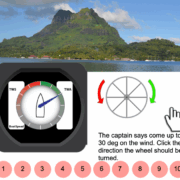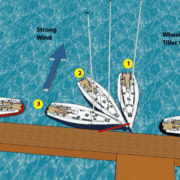Slow Tack or Fast Tack – That is the question
I once sailed with an ex-submarine captain who would turn the boat through a tack extremely slowly. When asked why, he had several good reasons.
(1) Look behind you as you come about. If you are leaving swirling water eddies behind the rudder, these are a sum of kinetic energy that was previously in your sailboat but has now been released to the water. What does that mean? If you jam the tiller over during a tack you will loose momentum – slowing down your sailboat more than you need to. If you execute an easy steady turn leaving the kinetic energy in the boat, you’ll maintain kinetic energy in the boat.. Thus when you come out on the other side your boat still has speed. Still not convinced? You’ll remember from docking that the boat carries a lot of momentum. Put the throttle in neutral and the speed bleeds off very slowly. Ever been skiing? Execute a few cutting turns and you’ll see how fast your speed drops. Same concepts when tacking.
(2) A slower turn also allows your crew a few extra seconds to get the jib sheet in tight before the real heel and tension comes on. This is really important because once you’re heeling over on the new tack it is more difficult and slower for the crew to tension up the jib sheet to it’s appropriate trim. It’s pretty frustrating as helms person when you’re perfectly on the new tack and you’re watching the crew floundering around cranking slowly on the winch and the jib is still only half in. You’re probably yelling “get it in get it in” and watching others pull past. What I’m doing here is putting a little responsibility back on you. With a slower turn, the crew can get the jib sheet almost all the way in by hand before the tension comes on.
(3) The swirling water eddies left a signature in the water that could be picked up by submarine hunting satellites. Not that this is relevant to sailing really but it was just his well formed habit.
The point is – when you’re the helms person, maintaining speed through the tacking maneuver is a balance between your boat’s momentum profile and your crew’s efficiency in getting that sheet in. It’s not about jamming the wheel over to the other side as fast as possible.
Just goes to show you that slow is faster. Ask the tortoise!







